contructor
构造函数和普通函数写法一样,只是我们习惯将构造函数大写。
function Car(color) {
this.color = color;
}
var redCar = new Car('redCar');
console.log(redCar);
// result
Car {color: "redCar"}
color: "redCar"
__proto__: // 是redCar的creator
constructor: ƒ Car(color) // constructor是creator的一部分
__proto__: Object
__proto__相当于prototype
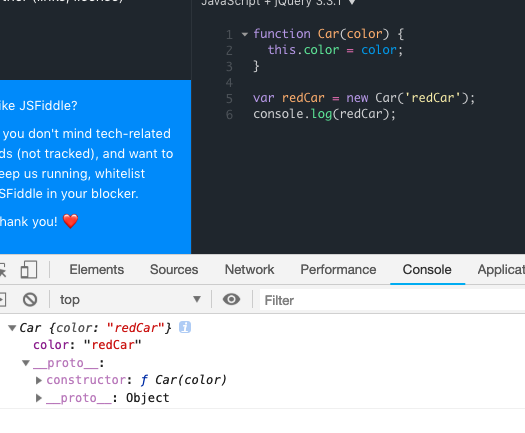 调用new的时候,设置contructor(Car)的内部属性(color),引用creator。
如果我们不用new,结果是undefined,因为Car没有返回任何结果。这样我们创建的属性就会挂在window下,在最开始加上'use strict'可以避免这种问题,此时this不是window对象,会报错
调用new的时候,设置contructor(Car)的内部属性(color),引用creator。
如果我们不用new,结果是undefined,因为Car没有返回任何结果。这样我们创建的属性就会挂在window下,在最开始加上'use strict'可以避免这种问题,此时this不是window对象,会报错
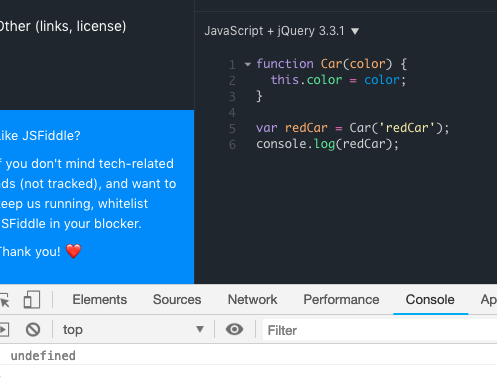
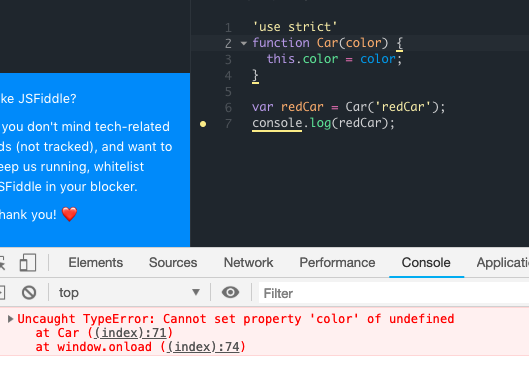
js中是没有私有属性的概念,我们可以通过闭包创建私有属性。 何为闭包? 在一个函数中可以访问另外一个函数中的变量,这个函数就是闭包,一个最简单的闭包如下
()()
function Car() {
var _color = 'red';
this.getColor = function() {
return _color
}
}
var redCar = new Car('redCar');
console.log(redCar._color); // undefined, 访问不到私有属性
console.log(redCar.getColor());// red
prototype
每个contructor都有一个prototype
function Car(color) {
this.color = color;
this.getColor = function() {
return this.color;
}
}
var redCar = new Car('red');
console.log(redCar);
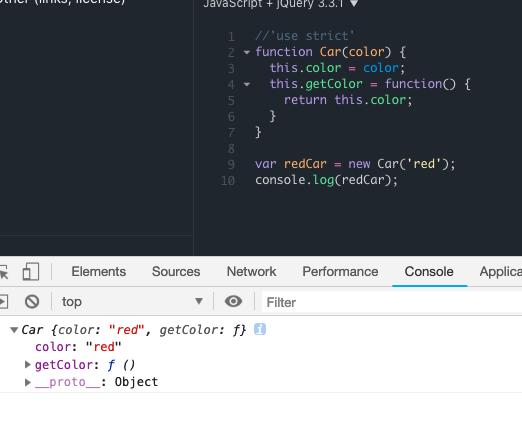 将getColor方法添加在prototype上
将getColor方法添加在prototype上
function Car(color) {
this.color = color;
}
Car.prototype.getColor = function() {
return this.color;
}
var redCar = new Car('red');
console.log(redCar);
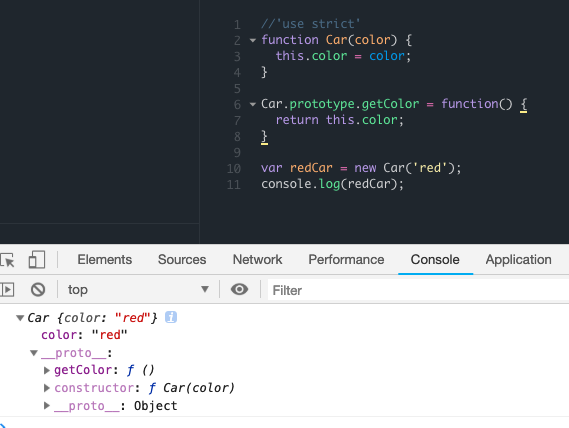
上图中我们的getColor方法在__proto__下,我们可以这么理解:
redCar下的__proto__和prototype是一样的,但是因为实例下(new出来的函数)只有__proto__属性,而构造函数的属性为prototype,我们可以测试一下redCar.__proto__===redCar.constructor.prototype返回结果为true
我们对上图__proto__下的constructor展开,发现包含prototype,继续展开发现包含constructor
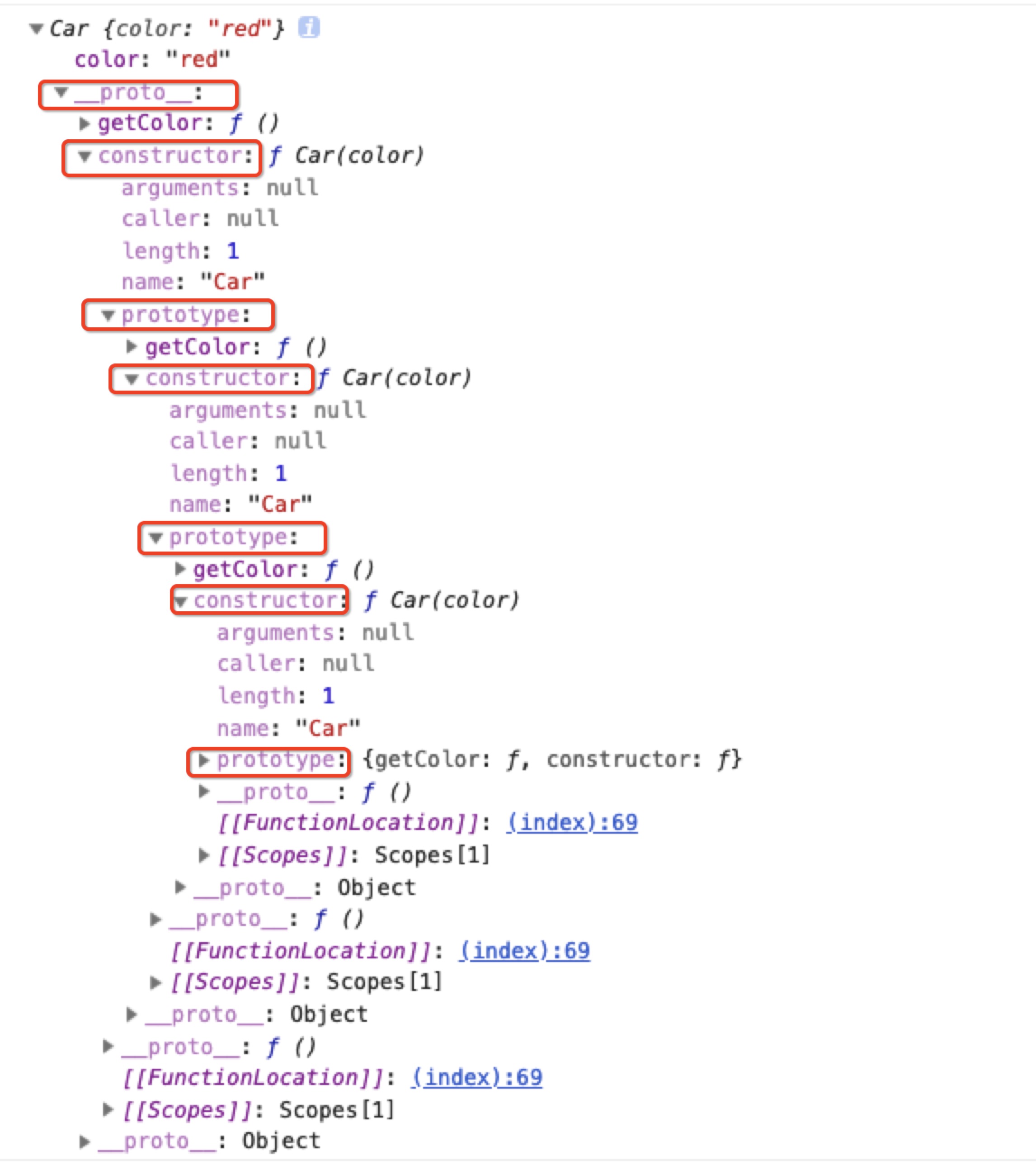
这里_proto__下的constructor就是我们的构造函数,构造函数下有prototype,一直循环往复,就产生了上面的嵌套。那么原型,构造函数,和实例的关系如何?
- 每个构造函数都有一个prototype属性,指向实例的_proto__属性
- 每个实例都有一个constructor属性,指向构造函数
Object.create
这个方法是创建一个新对象,使用现有的对象来提供新创建的对象的__proto__.有2个参数(prototypeObj, propertyObj)
const Car = function(color) {
this.color = color;
}
Car.prototype = {
getColor() {
return this.color;
}
}
const MyCar = function() {}
MyCar.prototype = Object.create(Car.prototype);
const useCar = new MyCar();
console.log(useCar instanceof MyCar);
console.log(useCar instanceof Car);
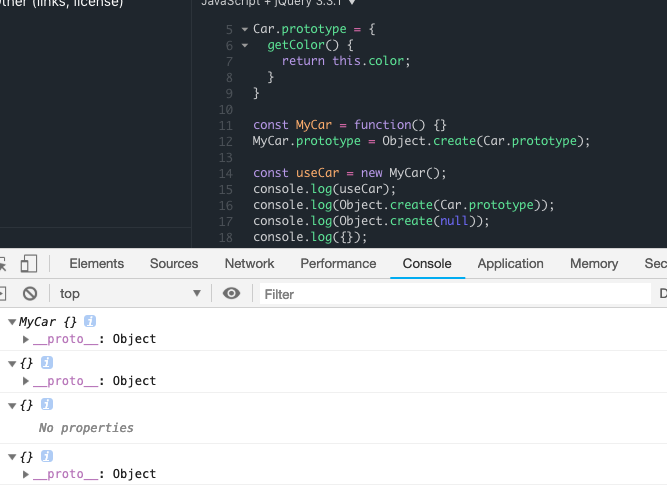
原型链
const Car = function() {}
Car.prototype.print = function() {
console.log('This is Car');
}
const MyCar = function() {}
MyCar.prototype = Object.create(Car.prototype);
MyCar.prototype.print = function() {
console.log('This is MyCar');
}
const UseCar = function() {}
UseCar.prototype = Object.create(MyCar.prototype);
UseCar.prototype.print = function() {
console.log('This is UseCar');
}
const useCar = New UseCar();
console.log(useCar.print());
useCar对象会沿着UseCar,UseCar的prototype, MyCar的prototype,Car的prototype属性一直往上找print方法,直到找到为止。
扩展构造函数
function Anaimal(name) {
this.name = name;
}
Anaimal.prototype = {
eat() {
return this.name + 'is eating';
},
sleep() {
return this.name + 'is sleep';
}
}
let Cat = function(name, age) {
Anaimal.call(this, name);
this.age = age;
}
Cat.prototype = Object.create(Cat.prototype); // Object.create重写__proto__
Cat.prototype.contructor = Cat;// 显示指定contructor
const cat = new Cat('kitty', 2);
console.log(cat);
分别是使用Object.create和没有使用Object.create的结果,可以看出第一个__proto__下没有,所以需要Cat.prototype.contructor = Cat;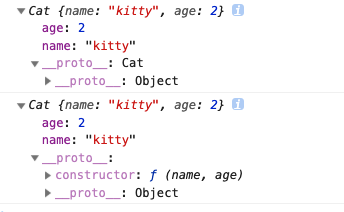
setPrototypeOf
setPrototypeOf方法设置一个指定的对象的原型 ( 即, 内部[[Prototype]]属性)到另一个对象或 null
let obj1 = {
eat() {
return 'obj1 eat';
}
}
let obj2 = {
sleep() {
return 'obj2 sleep';
}
}
Object.setPrototypeOf(obj2, obj1);
console.log(obj2);
Mixins
接收一个object作为参数,调用其他对象的方法,返回新的对象
const car = function(obj) {
let moving = false;
return Object.assign({}, obj, {
move() {
isMoving = true;
},
isMoving() {
return isMoving;
}
});
}
const superCar = function(obj) {
let fly = false;
return Object.assign({}, obj, {
move() {
isFly = true;
},
isFly() {
return isFly;
}
});
}
console.log(superCar(car({})));
static methods
static methods和common methods的区别
class Car {
contructor(color, price) {
return Object.assign({}, {color, price});
}
static comparePrice(car1, car2) {
console.log(car1.price - car2.price);
}
}
class Car {
contructor(price) {
this.price = price;
}
static sellCar(car) {
return `selling for ${this.price}`;
}
}
class BYD extends Car {
constructor(price) {
super(price);
}
static buyCar(car) {
return `BYD ${super.sellCar(car)}`;
}
}